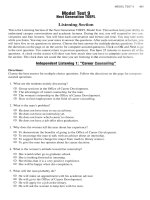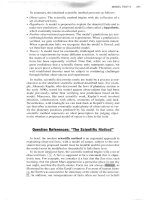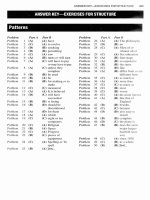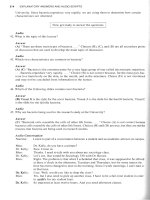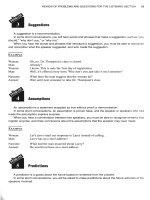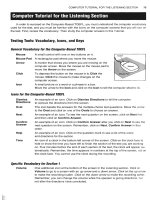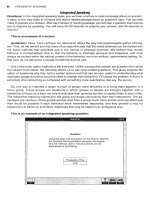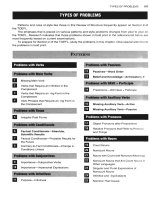Tài liệu How to prepare for the foefl part 24 docx
Bạn đang xem bản rút gọn của tài liệu. Xem và tải ngay bản đầy đủ của tài liệu tại đây (745.76 KB, 10 trang )
READING COMPREHENSION: PROBLEM
8
229
DIRECTIONS:
First, read the following passage. Then, refer back to the passage. Can you find the correct
reference? Check your answer using the key on page
487.
In September of
1929,
traders experienced a lack of confidence in the stock market's ability
to continue its phenomenal rise. Prices fell. For many inexperienced investors, the drop pro-
duced a panic. They had all their money tied up in the market, and they were pressed to sell
before the prices fell even lower. Sell orders were coming in so fast that the ticker tape at the
New York Stock Exchange could not accommodate all the transactions.
To try to reestablish confidence in the market, a powerful group of New York bankers
agreed to pool their funds and purchase stock above current market values. Although the buy
orders were minimal, they were counting on their reputations to restore confidence on the part
of the smaller investors, thereby affecting the number of sell orders. On Thursday, October
24,
Richard Whitney, the Vice President of the New York Stock Exchange and a broker for the
J.P.
Morgan Company, made the effort on their behalf. Initially, it appeared to have been success-
ful, then, on the following Tuesday, the crash began again and accelerated. By 1932, stocks
were worth only twenty percent of their value at the 1929 high. The results of the crash had
extended into every aspect of the economy, causing a long and painful depression, referred to
in American history as the Great Depression.
1.
Where in the passage does the author refer to the reason for the stock market crash?
2.
Where in the passage does the author suggest that there was a temporary recovery in the stock
market?
230
REVIEW
OF
READING
Read the following passage, using the skills you have learned. Preview, read for main ideas, and use
contexts for vocabulary. To read faster, read phrases instead of words.
Try
to see an entire line of text
when you focus your eyes on the passage. Scan for details and evidence. Make inferences.
The computer-based version of this reading passage is best viewed on the
CD-ROM
that supple-
ments this book. Scroll through the passage, using the skills that you have learned. Check your answers
on the scieen. If you do not have a computer, then use the print version shown with the following com-
puter-assisted questions.
Jazz is an improvisational form of music that
originated in the southern United States after the Civil War.
Although its origins and history are somewhat vague, we know
that it began as the musical expression of black people who
had formerly been slaves, combining hymns, spirituals, and
traditional work songs into something quite new. The style
was a blend of the rhythms brought to America by the Africans
Line
who were imported as slave labor and the popular music of the
(9)
era that featured the ragtime piano. The term jazz itself is of
obscure and possible nonmusical origin, but it was first used
to describe this particular kind of musical expression in about
191
5.
A jazz band commonly includes four to twelve musicians
with a relatively large proportion of the group in the rhythm section.
Customarily, there are a drummer, a bass player, and a pianist.
Often there is also a banjo player or guitarist. In traditional jazz,
the clarinet, trumpet, and trombone carry the melody.
In more modern jazz, the saxophone, violin, and flute may also
be included in the melody section. Some jazz bands employ
a blues singer. Most jazz is premised on the principle that
an almost infinite number of variations can accommodate
themselves to a progression of chords that can be repeated
indefinitely to feature an improvisation by solo instruments or
vocalists. For example, while the trumpet plays the melody,
the clarinet might embellish and invent compatible melodies
around the original theme. Such improvisation is a test of the
jazz musician's skill and is referred to as tone color.
Jazz first became popular outside the United States
in the 1920s when jazz bands began to record, distribute, and
even export their recordings to Europe. Since jazz is
improvisational, it does not exist in the form of printed scores.
and recorded performances were and still are the best way
of preserving the music. A very basic library of recorded jazz
would include work by such classic artists as Jelly Roll Morton,
Louis Armstrong, Duke Ellington, Count Basie, and Billie Holiday.
Theirs is probably America's most unique and most important
contribution to the musical world, although a few
contemporary artists are keeping the tradition alive.
TYPES OF QUESTIONS
231
Mulntiple-Choice Questions
Paper-Based TOEFL Computer-Based TOEFL
1.
Which of the following is the main topic
Which of the following is the main topic
of the passage? of the passage?
A definition of jazz
a
0
A
definition of jazz
GD
Jazz musicians
0
Jazz musicians
O
Improvisation in jazz
0
Improvisation in jazz
OD
Jazz bands
0
Jazz bands
2.
The new music of jazz was first heard
@
in Europe
GD
in Africa
O
in South America
CD
in North America
3.
The word "blend7' in the passage is closest
in meaning to
mixture
CD
rejection
O
imitation
CD
variety
The new music of jazz was first heard
0
in Europe
0
in Africa
0
in South America
a
0
in North America
The word
BIFfTT
in the passage is closest
in meaning to
a
0
mixture
0
rejection
0
imitation
0
variety
4.
The author mentions
all
of the following
The author mentions all of the following
as characteristics of jazz
EXCEPT
as characteristics of jazz
EXCEPT
a large number of percussion
0
a large number of percussion
instruments instruments
GD
a printed score for the music
0
a printed score for the music
O
a melody played by the trumpet
la3
a melody played by the trumpet
a
a ragtime piano
0
a ragtime piano
Answer
Sheet
1.oaaCD
2.rnCDO8
3.oCDoa
4.rnOOaD
Computer-Assisted Questions
Location Questions
On
some of the compu'ter-assisted questions, you will be asked to locate information
in
the pas-
sage. These questions are like the multiple-choice questions on the Paper-Based TOEFL where you
must locate information by identifying the line numbers in the passage.
On
the computer-assisted ques-
tions, you must click on the sentence or paragraph in the passage.
232
REVIEW
OF
READING
-t
Jazz
IS
an rmprov~sat~onal lorm ol musrc that
Click on the sentence
in
paragraph
1
originated In the southern United Stales after the Civil War.
in which the author mentions the
derivation of the word "jazz."
Although its origins and hislory are somewhat vague, we know
that it began as Ihe musical expression of black people who
Paragraph
1
is marked with an
had formerly been slaves, combining hymns, spirituals, and
arrow
(+).
Iradilional work songs into something quite new. The slyle
was a blend ol the rhythms brought to America by the Africans
who were imported as slave labor and the popular music of the
era lhat featured the ragtime piano. The term
jazz
itsell
is
of
obscvre and possible nonmusical origin, but it was first used
to describe this oatiicular kind of musical exoresslon in abwl1915.
A jazz ban'd commonly includes four'to twelve musicians
with a relatively large proportion of the group in the rhythm section.
Customarily, there are a drummer, a bass player, and a pianisl.
Often there is also a banjo player or guilarist. In lraditional
jazz,
the clarinet, Irumpet, and trombone carry Ihe melody.
In more modem jazz, the saxophone, violin, and flule may also
be
included in the melody section. Some
jazz
bands employ
a blues singer. Most
jazz
is premised on the principle lhat
an almost infinite number of variations can accommodate
Synonyms
On some of the computer-assisted questions, you will be asked to locate synonyms in the reading
passage. You must click on the word or phrase
in
the passage.
was a blend of the rhythms brought to America by the Africans
who were imported as slave labor and the popular music of the
the
bold
text
,ha,
is
closest
in
era thal featured the ragtime piano. The lerm jazz itself is of
meaning to commonly
obscure and Dossible nonmusical origin, but it was first used
1
lo
describe thb parlicular kind of musical expression in about
1915,
A
Ian
band commonly includes four to
twelve
musicians
with a
&ti
large of
the
group
in
the
rhythm section.
Cuslomarlly,
there
are a drummer, a bass player, and a pianist.
Often
there-is also a banjo player or
in
traditional
jazz,
the clarinet, trumpet, and trombonecarry the melody.
In more
modem
jazz,
the saxophone, violin, and flute may
also
be
included
in
the melody section. Some
jazz
bands employ
a blues singer. Most jazz is premised on the principle Ihat
an almost infinite number of variations can accommodate
themselves to a progression of chords that can be repeated
indefinitely to feature an improvisation by solo instruments or
vocalists. For example, while the trumpet plays the melody,
the clarinet might embellish and invent compatible melodies
around the original theme. Such improvisation is
a
test of the
z musician's skill and is referred to as tone color.
TYPES
OF
QUESTIONS
233
Paraphrased sentences
On some of the computer-assisted questions, you will be asked to identify paraphrases of sen-
tences in the passage.
I
be ~ncluded in the melody section. Some jazz bands employ
a blues singer. Most jazz is premised on the principle that
an almost infinite number of variations can accommodate
themselves to a progression of chords that can be repeated
indefinitely to feature an improvisation by solo instruments or
vocalists. For example, while the trumpet plays the melody,
the clarinet might embellish and invent compatible melodies
around the original theme. Such improvisation is a test of the
jazz
musician's skill and is referred to as lone color.
Jazz
first became popular outside the United States
in the 1920s when jazz bands began to record, distribute, and
even expati thei~recordings to Europe. Since
iaz
is
,
_
<.
improvisational, it does not exist in the form of printed scores,
and recorded performances were and still are the best way
of preserving
the
music. A very basic library of recorded jazz
would include work by such classic artists as Jelly Roll Morton,
Louis Armstrong, Duke Ellington, Count Basie, and Billie Holiday.
Theirs is probably America's most unique and most important
contribution to the musical world, although a few
contemporary artists are keeping the tradition alive.
What does the author mean by the
statement Since jazz is improvisational, it
does not exist in the form of printed scores,
and recorded performances were and still
are the best way of presewing the music.
0
Because jazz
is
not written down,
it is not preserved.
=Today jazz has written scores
like other forms of music.
0
Jazz is prese~ed in audio
recordings instead of in written
media.
0
There are not very many copies
of the early jazz performances.
Reference Questions
On some of the computer-assisted questions, you will be asked to locate the nouns to which pro-
nouns refer. These questions are like the multiple-choice questions on the Paper-Based TOEFL where
you must choose the noun from four answer choices. On the computer-assisted questions, you must
find the noun and click on it in the passage.
Jazz is an improvisational form of music that
originated in the southern United States after the Civil War.
Although its origins and history are somewhat vague, we know
that it began as the musical expression of black people who
had formerly been slaves, combining hymns, spirituals, and
traditional
work
songs into something quite new. The style
was a blend of the rhythms brought to America by the Africans
who were imporled as slave labor and the popular music of the
era that featured the ragtime piano. The term Jazz itself is of
obscure and possible nonmusical origin, but
it
was
first
used
to
describe
this particular kind of muslml expression in about
1915.
A jazz band commonly includes four to helve musicians
with a relatively large proporlion of the group in the rhylhm section.
Customarily, there are a drummer, a bass player, and a pianist.
Often there is also a banjo player or guitarist. In traditional jazz,
the clarinet, trumpet, and trombone carry the melody.
In more modern jazz, the saxophone, violin, and flute may also
be ~ncluoea
n
the melody section. Some
jazz
mnas empoy
a blues singer.
Most
jazz is premised on the principle that
Look at the word it
In
the passage.
Click on the word or phrase in the
bold text that it refers to.
an almost lnfinlte number of vanat~ons can accommodate
MI
a
mmE
234
REVIEW
OF
READING
Sentence Insertion Questions
On some of the computer-assisted questions, you will be asked to locate the most logical place in
the passage where a sentence could be inserted. You will have several options marked with a square
(W)
in the passage.
The following sentence can be added
-+
Jazz is an improvisational form of music that
to paragraph
1.
oriainated in the southern United States after the Civil War
~lthou~h its origins and history are somewhat vague, we know
It is generally agreed that the term
that began as the musical expression of black people who
became popular not in the South
had lormerly been slaves, combininq hymns, spirituals, and
but in Chlcago.
traditional work songs into something quite new.
n
The slyle
was a blend of the rhythms brought to America by the Africans
who were imporled as slave labor and the popular music of the
era that featured the ragtime piano. W The term
jazz
itself is of
obswre
and
possible nonmusml origin,
butt
was
first
used
to
desaibe
ltas
pardcub
ldnd
of
musical
expsb in
about
1915.
W
It
is
generally
agreed
that
the
term
kcme
popular
not
in
the
Swlh
but
in
Chicago.
A jazz band commonly includes lour to twelve musicians
with a relatively large proporhon of the group in the hylhm section.
Customarily, there are a drummer, a bass player, and a pianist.
Oilen there is also a banjo player or guitarist.
In
traditional
jazz,
the clarinet, trumpet, and trombone
carry
the melody.
In more modem jazz, the saxophone, violin, and flute may also
be included in the melody section. Some
jazz
bands employ
a blues singer. Most
jazz
is premised on Ihe principle that
-
Where would it best fit in the
paragraph?
Click on the
square
[
rn
]
to add
the sentence to the paragraph.
1
Paragraph
1
is
marked
with
an arrow
I
Testing Tools: Vocabolary, Icons, and Keys
Specific Vocabulary for Section
3
Scroll
To move through reading passages on a screen. If the reading passage is long, new
sentences will appear at the bottom and sentences that you have already read will
disappear at the top.
Specific Icons for Section
3
Scroll Bar
An icon used to move the reading passages on the screen so that you can see a long
passage. First move the arrowto the top of the scroll bar; then hold the mouse button
down to move the scroll bar from the beginning of the reading passage to the end.
Remember, you can see the words beginning, more available, and end at the top
of
the scroll bar. These words show you the place in the passage that is displayed
on
the screen.
TYPES
OF
QUESTIONS
235
Proceed An
icon
at the bottom of the screen with the reading passage.
Click
on Proceed after
you have read the passage in order to see the first question. Remember, you cannot
use Proceed until you have scrolled down to the end of the passage.
Previous
An
icon
at the bottom of the screen with the questions.
Click
on Previous to see the
previous question.
Computer Screens for Section
3
the passage more available, end
rase the~r heads to look at thlngs They also begln to
sm~le at people By four months, the baby
IS
searching
for thlngs but not yet grasplng them w~th 11s hands It
IS
also beglnnlng to be wary of strangers and may
scream when a vls~t~ng relatlve trles to plck ~t up By
flve months, the baby
IS
grabblng objects and putting
them Into ~ts mouth Some bab~es are trylng to feed
themselves w~th thew hands
In m~ddle Infancy, the baby concentrates on
practlclng a great many speech sounds Babbllng
becomes a part of play It also loves to lmltate actlons
and examlne lnterestlng Objects At about seven
TO SEE THE FIRSTOUESTION
months, 11 beg~ns to crawl, a sk~ll that
rt
masters at the
end of m~ddle lnfancy In late Infancy, the baby takes
Read to the end of the passage
an Interest In games, songs, and even books
Cllck to go to another screen
Progress toward walklng moves through
standing.
-
See the flrst questlon bes~de
balancing,
bounc~ng In place, and walk~ng wlth others
Proceed
the readlng passage
As soon as the
baby
walks well alone. it has passed
from Infancy Into the actlve toddler stage
Cllck to go to the
prevlous screen
TO
SCROLL
1
Move the arrow to the scroll bar
2
Hold down the mouse button
Move vertically down the scroll bar
I
236
REVIEW
OF
READING
You should use the scroll bar to read
the whole passage before you begin
to answer the questions.
However, the passage will appear again
with each question.
TO
SEE
THE
QUESTIONS
Click to return to the
read~ng passage
Finish reading
the
passage
Click on Prbceed
TIP:
When you do not scroll to the end of the reading passage the first time you see it, this screen
appears. You can spend a lot of time returning to the passage. Until you scroll to the bottom of the pas-
sage, you cannot see the questions.
TYPES OF QUESTIONS
237
Although each baby has an ~ndrviduai schedule of
development, general patterns of growth have been
observed. Three periods of development have been
identified, including early infancy, which extends from
the first to the sixth month; middle infancy, from the
sixth to the ninth month; and late infancy, from the
ninth lo the fifteenth month. The newborn is concerned
with his or her inner world and responds primarily to
hunger and pain and reflexes govern its movement in
response to st~muli. In contrast, by early infancy the baby
is
already aware of the surrounding world. During the
second month, many ~nfants are awake more and can
raise their heads to look at things. They also begin to
smile at people. By four months, the baby is searching
for things but not yet grasping them with its hands. It is
also beginning to be wary of strangers and may
scream when a visiting relative tries to pick it up. By
five months, the baby is grabbing objects and putting
them into its mouth. Some babies are trying to feed
themselves with their hands.
In middle infancy, the baby concentrates on
practicing a great many speech sounds. Babbling
becomes a
part
of play. It also loves to imitate actions
1
Read the directions. There are
different types of questions,
with special directions for each type
Follow the directions for the
TIP:
The answer to the question on the right side of the screen is always found in the part of the
passage visible on the left side of the screen. You usually do not have to scroll through the passage to
find the answer.
Simulations for Section
3
In order to prepare for the experience that you will have on the Computer-Based TOEFL, you can
use the CD-ROM that supplements this book. Locate the Reading section on the Model Tests. The com-
puter will simulate the Reading section on the Computer-Based TOEFL. These model tests are com-
puter-assisted. The Reading section of the Computer-Based TOEFL is not computer-adaptive.
As part of your study plan, be sure to review all of the questions in all of the Model Tests. Use the
Explanatory Answers on the CD-ROM or in Chapter
10.
If
you do not have a computer, you can still simulate some of the features of the Computer-Based
TOEFL. Section
3
of Model Tests
1-8
in Chapter
8
of this book is printed in two columns to give you the
same kind of visual impression that you will have when you read from a computer screen. The on-
screen directions for computer-assisted questions are also printed in the book.
238
REVIEW
OF
READING
The Next Generation TOEFL will include authentic textbook passages about twice as long as those
that are presented on the current Computer-Based TOEFL.
The next edition of this book will include a new, revised Reading Chapter to introduce you to acad-
emic reading strategies for these longer texts.
Watch for
Barron's
How
to Prepare for the TOEFL, 12th Edition
to be published when the Next
en era ti on
TOEFL is introduced.
Practice reading on a computer screen.
Reading on a computer screen
is
different from
reading on
a
page. First, there
is
generally
less
text visible; second, you must scroll instead of turning
pages; and finally, there may be quite a few icons or other distracting visuals surrounding the passage.
To become comfortable with reading on a computer screen, you should take advantage of every oppor-
tunity you have to practice.
If
you have
a
computer, spend time reading on the screen. Everything you
read will help you improve this new
skill.
Practice reading the kinds of topics you will find in the Reading Section.
An inex-
pensive encyclopedia on CD-ROM would be
a
good investment. The kinds of passages found on the
Computer-Based
TOEFL
are
very similar to those found in
a
basic English encyclopedia.
If
you do not
have
a
computer, you may be able to locate software for an English encyclopedia at a local library
where a computer
is
available for public use.
Become familiar with the directions for each of the question types.
The different
types of questions will appear at random. Directions will appear with each question, but
if
you already
recognize the type of question presented, and you are familiar with the directions, you will save time.
The less time you have to spend reading directions, the more time you will have to read the passages.
Why are you preparing for the TOEFL? What goal is motivating you to study and improve your
score? Do you want to attend a university in the United States or Canada? Do you want to
try
for a
scholarship from a sponsor in your country or region? Is the TOEFL required for graduation from your
high school? Do you plan to apply for an assistantship at a graduate school? Do you need the score for
a professional license in the United States?
Goals can be experienced as mental images. You can close your eyes and imagine everything, just
like a movie. See yourself achieving your goal. Watch yourself as you attend school or practice your
profession in your ideal environment. See other people congratulating you. Enjoy the success.
Understand that you cannot control reality with visualization. However, it does change your atti-
tude, it helps you to focus, provides motivation, and reduces stress. Visualization is an excellent way to
take a short break from studying.
